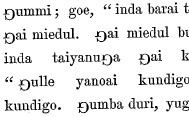 | ||
Eng or engma (capital: Ŋ, lowercase: ŋ) is a letter of the Latin alphabet, used to represent a velar nasal (as in English singing) in the written form of some languages and in the International Phonetic Alphabet.
Contents
History
The First Grammatical Treatise, a 12th-century work on the phonology of the Old Icelandic language, uses a single grapheme for the eng sound, shaped like a g with a stroke ⟨g⟩. Alexander Gill the Elder uses an uppercase G with a hooked tail and a lowercase n with the hooked tail of a script g ⟨ŋ⟩ for the same sound in Logonomia Anglica in 1619. William Holder uses the letter in Elements of speech: An essay of inquiry into the natural production of letters, published in 1669, but it was not printed as intended; he indicates in his errata that “there was intended a character for Ng, viz., n with a tail like that of g, which must be understood where the Printer has imitated it by n or y”. It was later used in Benjamin Franklin's phonetic alphabet, with its current phonetic value.
Appearance
Lowercase eng is derived from n, with the addition of a hook to the right leg, somewhat like that of j. The uppercase has two variants: it can be based on the usual uppercase N, with a hook added (or "N-form"); or it can be an enlarged version of the lowercase (or "n-form"). The former is preferred in Sami languages that use it, the latter in African languages, such as in Shona from 1931–1955.
Early printers, lacking a specific glyph for eng, sometimes approximated it by rotating a capital G, or by substituting a Greek eta (η) for it (encoded in Unicode as the Latin letter n with long leg: Ƞ ƞ).
Technical transcription
Vernacular orthographies
Languages marked † no longer use eng, but formerly did.
Computer encoding
Eng is encoded in Unicode as U+014A LATIN CAPITAL LETTER ENG and U+014B LATIN SMALL LETTER ENG, part of the Latin Extended-A range. In ISO 8859-4 (Latin-4) it's located at BD (uppercase) and BF (lowercase).
In African languages such as Bemba, ng' (with an apostrophe) is widely used as a substitute in media where eng is hard to reproduce.
